Just a little over a year ago, I reviewed the e-Q7, one of the first IEM to use the innovative moving armature transducer and certainly one of the top-tier universal IEM in the market. For those who are not familiar with moving armature, this Japanese invented transducer is a sort of hybrid, with diaphragm like moving coil transducer and motor like balanced armature (BA). It is this combination of design that gives the moving armature a unique sound –the speed and accuracy of a BA plus the dynamic and impact of a moving coil under one single driver. Yet this single driver is well enough to compete with some of the best universal multi drivers IEM in the market. With the success of e-Q7, Ortofon follows up with the recent release of e-Q5 – Built on the same moving armature technology, it is said that Ortofon is managed to make a less expensive IEM, yet retains the level of sound quality. Is it too good to be true?
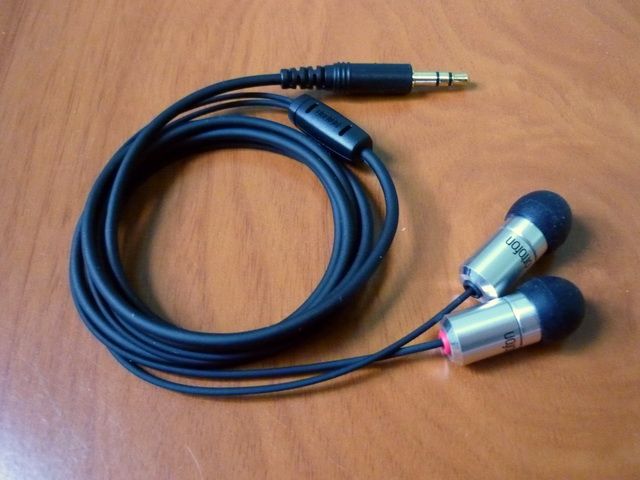
Spec
Driver: Single Balanced Armature
Frequency Response: 10Hz – 20kHz (+/- 3dB)
Sensitivity: 118dB SPL/mW
Impedance: 40 ohms
Maximum Rated Input Power: 5.0mW
Weight: 15.9g
Cable: 1.2m, Silver Plated 4N OFC.
Packaging, Accessories, and Build Quality
Unfortunately I only receive the IEM itself but not the full package, so there won’t be much discussion on packaging and accessories. In any case I think there is enough picture of the packaging floating around on the web that you can research it out yourself. The interesting bit is that Ortofon goes with a metal cylinder, or biscuit can as I like to call it, for the package (with a paper box on the outside). Accessories wise, the filter, filter ring, filter cleaning tool, silicone eartips and Comply foam tips are pretty much the same as e-Q7. The one thing missing is the really great leather case. I can understand they want to save cost since e-Q5 is supposed to be cheaper than e-Q7, but I do think they should have at least included a hard nylon case, as those are pretty cheap. e-Q5 is simply too nice to not have a case of its own. I’ll strongly suggest those of you who want to get a pair of e-Q5 also find yourself a hard case at the same time.
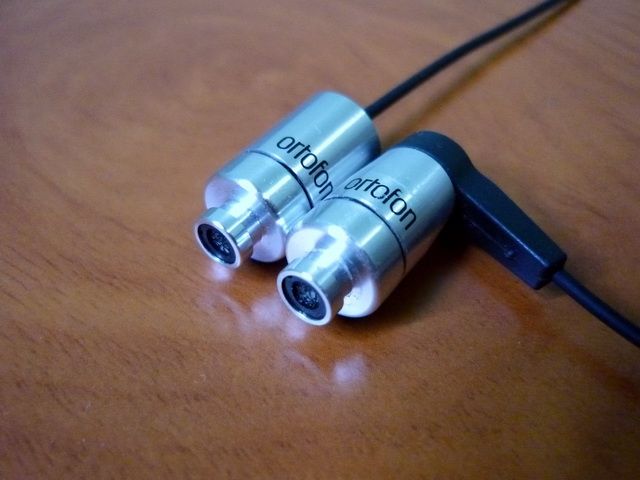
Ortofon e-Q5 (top) and e-Q7 (bottom)
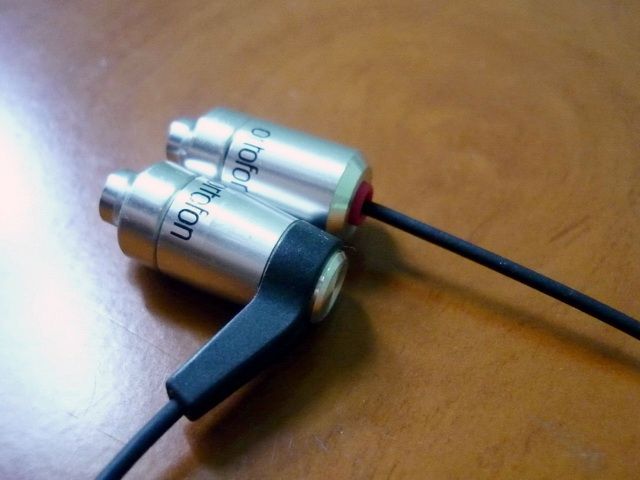
From the back
The build quality is excellent, as you would expect from a brand like Ortofon and a place like Japan (which is where the IEM is manufactured). As you can see, the earpieces feature a strain-relief-less, earplug like design. Though it is almost the same type of cable as e-Q7 (*the new cable is a tad softer actually), the new design means you shouldn’t in anyway try to remove the earpiece by pulling the cable. Also, Ortofon also removes the fabric sheath (found on e-Q7’s Y-splitter down) and replace it with the same type of extra soft rubber as like those closer to the earpiece, but thicker in diameter. I don’t have any problem with the old cable, but I guess there are those who find the fabric sheath a bit too microphonics for them. The other improvement on the cable is the strain relief on the 3.5mm plug, which isn’t hard anymore and more functional. Unfortunately not all are great. First, the new earpieces design means over-the-ear wearing is not easy for me, to say the least. The lack of cable slider on the Y-splitter is not helping either. Second, the same design coupled with the weight of the cable make the earpiece much easier to fall out than e-Q7. The easy solution will be to use a shirt clip, which unfortunately is not included. To make it work, standard shirt clip won’t fit properly on the thicker cable. After destroying one shirt clip in experiment, I ended up modifying one that will work on the e-Q5 cable (basically it is a Etymotic ER6i style shirt clip with part of the side cut away to accommodate the thick cable). With the shirt clip in place, the first and second issues become much less a problem. As a bonus, it is actually even less microphonics that the rubber cable alone. Isolation is a bit below average. Decent for street use but not for busy commute or any noise environment.
Beside those minor issues, my overall experience of using the e-Q5 has been quite positive. I know there are complaints from user with smaller ears on fitting issue with e-Q7. Since the new e-Q5 has almost the same nozzle design as the e-Q7, I can foresee the same fitting issue will arise with people of small ears. This will be something to consider before you pick up a pair of Ortofon.
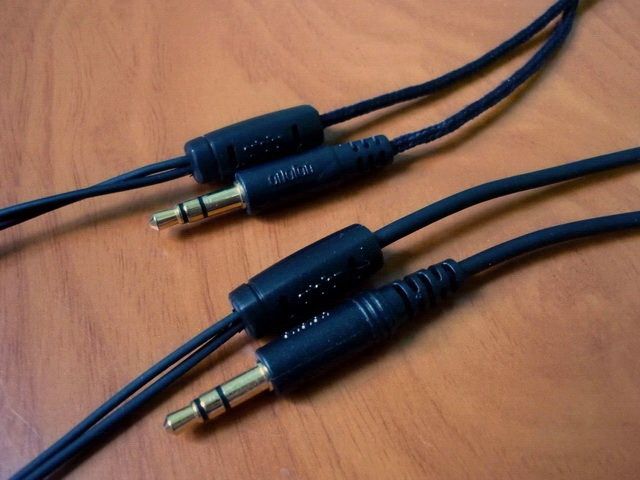
The cable on e-Q7 (top) has fabric sheath, while the cable on e-Q5 (bottom) is just soft rubber. Also notice the better strain relief on e-Q5.
Sound Quality
As usual, a 50+ hours of burn-in is carried out before the review. Like e-Q7, I didn’t detect any particular improvement after the burn-in process even though moving armature features a moving coil like diaphragm. Like moving coil transducer, the housing actually plays a part in tuning the final sound. Similar to e-Q7, the elongated housing at the back of the transducer forms an acoustic chamber to help deepening the mid and bass body, given a more moving coil quality to the final sound that is unusual to balanced armature. There are saying (which I can’t confirm) that the e-Q5 could have shared the same transducer as the e-Q7, which won’t be surprising given the great degree of sonic similarity between the two IEM. Yet they are not identical sounding, which perhaps attribute to the different tuning made by the housing.
The overall sound signature is warm, sweat and smooth with a good sense of balance and detail, less mid focus compared to e-Q7. Bass loses a bit of impact and quantity from e-Q7, but gain better depth and slightly more texture. Mid is still sweet with good body but not quite as forward as e-Q7. While still a dominating factor in the overall sound, it allows the other frequency to play a bigger role. Treble no longer has the slight roll off at the top and extends at a very smooth yet detail way, sparkly while not bright in any sense. Soundstage is where I find the most improvement over e-Q7. While it might not be a lot wider, it is airier, more transparent with better depth and layers.
In my review of e-Q7, I described its sound as “the midway of SE530 and UM2”, a good mix of the sweetness from SE530 with the warm, smoothness of UM2. With e-Q5 however, I like to think that the IEM has gone above SE530 and UM2, giving a new definition of what is warm and sweet at its best.
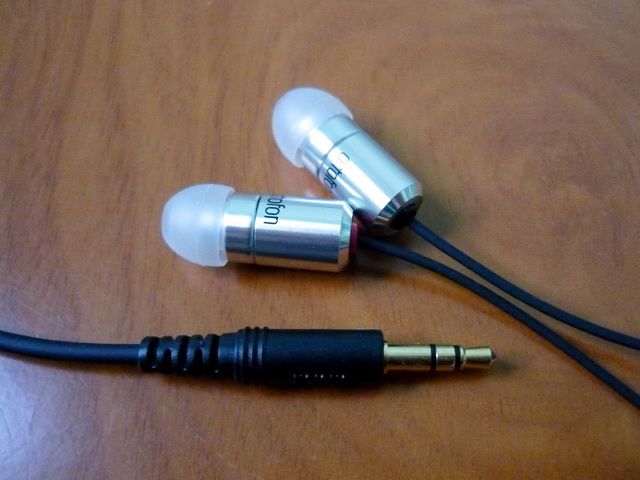
Verdict
Sonic wise, I think e-Q5 has edged out its elder brother a little bit with a more transparent and balanced sound. However, it is not to say e-Q7 is not a better choice for vocal listener. I predicted a year ago that this new generation of moving armature transducer will become better with time, and e-Q5 is here to proof it. While I can still see minor physical improvement that can be carried out on the new e-Q5, the fact that it is slightly cheaper that e-Q7 and Ortofon is having better international availability than a year ago do make this a more attractive buy. Though e-Q5 does have a lower street price in Japan (around $250), the popular demand of this model* internationally probably means we won’t see a significant drop in street price too soon, at least not till the demand slows down. In any case, a less than US$300 top-tier IEM is still well worth my recommendation to you.
*Ortofon Japan already runs out of stock and still waiting for the next batch to be manufactured in early 2011.
This above rating is for Ortofon e-Q5 only and may change without notice. Please refer to the list for a complete listing






